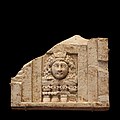Metaphor
Metaphor is a term for a figure of speech.[1] It does not use a word in its basic literal sense. Instead, it uses a word in a kind of comparison. We run, and we also say rivers run. We may run into trouble, especially if we run up a bill at the bar.
So a metaphor uses words to make a picture in our mind. It takes a word from its original context, and uses it in another.
- "I beat him with a stick" = literal meaning of 'beat'.
- "I beat him in an argument" = metaphorical meaning of 'beat'.
Metaphors are an essential part of language: it is not possible to speak or write without them.[2][3] A simple example is the word "run". This has a basic meaning of "moving quickly" or "go with quick steps on alternate feet, never having both feet on the ground at the same time".[4] The Concise Oxford Dictionary then gives 34 other uses as a verb; 21 uses as a noun; about 50 uses in short phrases. All of these are metaphors, although we do not usually notice this.
We use metaphors to make indirect comparisons, but without using 'like' or 'as' – because that would be a simile. A simile is a direct comparison: "Jane is like a child".
A metaphor very often uses the verb 'to be': "love is war", for example, not "love is like war" (that is a simile). Poetry includes much metaphor, usually more than prose.
Spam is an example that any email user knows about – this word was originally a metaphor, from 'Spam', a type of canned meat. Servers putting unwanted email into somebody's inbox was similar to waiters putting unwanted Spam into food. This was originally suggested by a Monty Python scene. When we use a metaphor very often and we forget the old meaning, or forget that the two meanings are connected, this is a 'dead metaphor'.
Originally metaphor was a Greek word for 'transfer'. It came from meta ('beyond') and pherein ('carry'). So the word metaphor in English was a metaphor, too. Today in Greek, metaphor is a trolley (a thing that is pushed for carrying shopping or bags).
- Most metaphors are concepts: see conceptual metaphor.
- Idioms use metaphors, or are metaphors: for example, the English phrase to kick the bucket means to die.
Simple metaphors
Description
A compound metaphor is one where there are multiple parts in the metaphor that are used to snag the listener. These parts may be enhancement words such as adverbs, adjectives, etc.
Each part in the compound metaphor may be used to signify an additional item of meaning.
Examples
Two people walk off a tennis court. Someone asks the loser: "What happened?".
- "He won". Literal truth.
- "He beat me". Obviously a dead metaphor.
- "He thrashed me". This one is slightly alive.
- The river runs. Dead, and many variations on this theme.
- Electricity is a fluid. Nearly dead.
- All our efforts are running into the sand. Live.
Complex metaphors
Compound metaphors
Live and dead metaphors
A live metaphor is one which a reader notices. A dead metaphor is one no-one notices because it has become so common in the language.
Metaphor Media
A political cartoon by illustrator S.D. Ehrhart in an 1894 Puck magazine shows a farm-woman labeled "Democratic Party" sheltering from a tornado of political change.
"The Asherah is part of a jigsaw in weaving together the feminine threads of a religious history that could be an important new breakthrough for women, she says." An example of mixed metaphor in print.
A metaphorical visualization of the word anger
Tombstone of a Jewish woman depicting broken candles, a visual metaphor of the end of life
Related pages
References
- ↑ "Metaphor" at Rhetoric.byu.edu; retrieved 2012-1-14.
- ↑ McArthur, Tom 1992. The Oxford companion to the English language. Oxford University Press. Metaphor, p653, especially section 'The universality of metaphor', p654. ISBN 0-19-214183-X
- ↑ Lakoff G & Johnson M. 1980, 2003. The metaphors we live by. University of Chicago Press. ISBN 978-0-226-46800-6
- ↑ Concise Oxford Dictionary, 9th ed.



